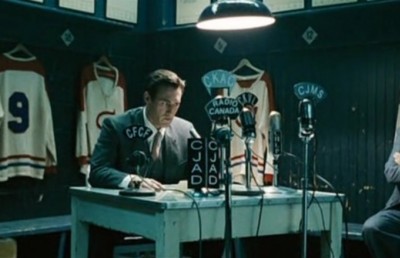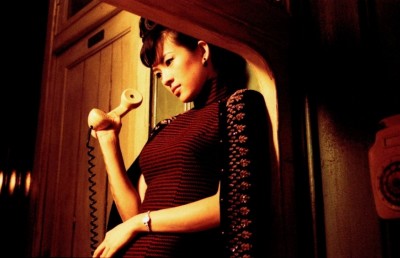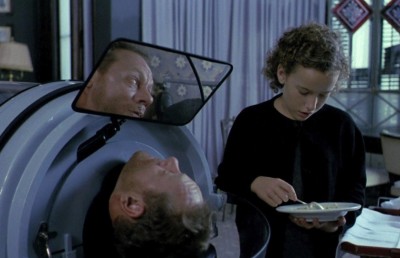Reflections in a Glass Cage
From Primitive to Modern Violence
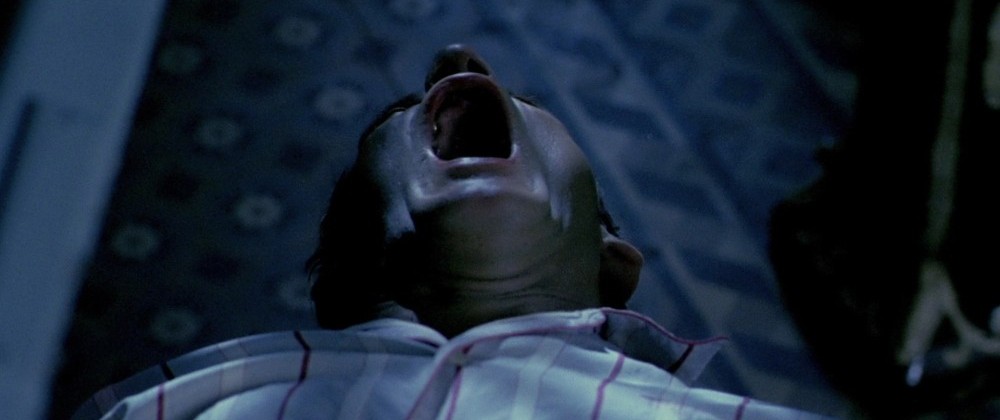
In a Glass Cage (Agustín Villaronga) is a film which has, over the years since its release in 1986, garnered a notorious semi-underground reputation as one of the most emotionally wrenching psychological horror films ever made. A film with some excruciatingly hard to watch moments, In a Glass Cage belongs to a smallish group of films that straddles several genres that make strange bed fellows: part horror film, part art film, and part exploitation film. A type of film which has recently been referred to by genre theorists such Jeffrey Sconce and Joan Hawkins as “paracinema”: a cross-generic cinema which eliminates the distinction between high art and trash/exploitation/low art by focusing on visceral emotionalism, on affect: “the ability of a film to thrill, frighten, gross out, arouse, or otherwise directly engage the spectator’s body.” (Hawkins, p. 4) The paracinema would be part of what Carol Clover and Linda Williams have called ‘body genres’; genres which place as their prime aim the titillation of the body, those being horror (violence, blood, gore), porn (sexual arousal) and melodrama (weeping). Paracinema classics would include Un Chien Andalou (1929, Dali, Buñuel), Eyes Without a Face (1959 Georges Franju), Blood and Rose (1960, Roger Vadim), Weekend (1967, J.L. Godard), WR: Mysteries of an Organism (1971, Dusan Makavejev), The Act of Seeing With One’s Own Eyes (1972, Stan Brakhage), Andy Warhol’s Frankenstein & Andy Warhol’s Dracula (1973, P. Morrissey), and Possession (1981, A. Zulawski).
Seen within the paracinema, In a Glass Cage is most like a conglomeration of the horror film and the art film. It belongs to the former because it has two central characters that commit despicable, ugly things, and has intense set-pieces that climax in extreme violence. It brushes with the art film because of its ambiguity (both morally and narratively), and its shift from a plot-driven narrative to a practically dialogue-less, stylized chamber piece. Because of its association of political fascism (Nazism) with perverse sexuality (pedophilia, sadism), homosexuality, and murder, some critics have compared In a Glass Cage to Liliana Cavana’s The Night Porter (1974) and Pier Paolo Pasolini’s 120 Days of Sodom (1975); however, Marsha Kinder, in her excellent book on Spanish cinema, Blood Cinema: The Reconstruction of National Identity in Spain, prefers to contextualise the film within post-war, post-Franco Spanish political and cultural history. Before getting to the possible multiple meanings of this complex, yet primal film, a brief description of the film’s narrative is in order.
The film opens with an unsettling pre-credit scene where we see the central character, a former Nazi doctor named Klaus (Gunter Meisner), photographing a young boy who is hanging Christ-like from his arms, his nude body bloodied and beaten. The boy’s indifferent expression suggests that he has suffered much, and has no energy left to struggle. Shots from within the dank basement are intercut with hand-held subjective point of view shots looking into the brutal scenario from outside the basement window, giving the audience information that the Klaus character does not have: he is being spied on, voyeuristically, but oddly enough, without interference. Klaus slowly brushes himself up along the boy’s body, smelling the chest and gently kissing the boy on the lips, who remains still and unmoved. He then moves behind the boy, picks up a wooden plank, clubs him fatally in the back of the head (off screen), and walks up to the roof of the building. The scene cuts back to the torture chamber, where a hand-held subjective point of view camera, accompanied by heavy breathing, moves into the room where the unseen voyeur bends down to pick up the doctor’s opened diary, which reveals drawings and scribblings. The scene concludes with Klaus jumping off the roof in a failed suicide attempt. The first shot after this scene is a close-up of a photo of Klaus holding the hand of a young boy, who we later learn is Angelo (David Sust), the unseen off screen presence of the pre-credit scene.
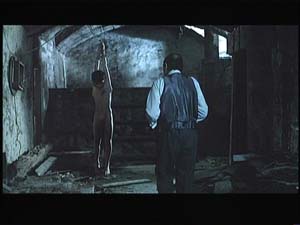
After a temporal ellipsis of a few weeks or months, the post-credit scene continues the opening’s festishistic treatment of the boy’s battered body with a long, lateral tracking shot along the side of a bluish iron lung. Lying in the iron lung is Klaus, who was paralyzed by the fall. Klaus lives with his wife Griselda (Marisa Paredes), young daughter Rena (Gisela Echevarria), and house maid Jornalera (Imma Colomer). A young man named Angelo (an avenging ‘angel’?) arrives unexpectedly, asking for the job of Klaus’ live-in nurse maid. Against the wife’s better judgement, Klaus insists that Angelo be hired. What ensues is a descent into the tormented psyche of young Angelo, as he becomes obsessed with Klaus’ murderous past and begins to enact Klaus’ sadistic acts as described in his diary. After murdering Klaus’ wife and relieving the maid of her duties, Angelo assumes ‘fatherhood’ of the crumbling Catalian estate, telling Rena “I am your father.” Angelo begins to act on his newly formed role of master “Nazi” father, erecting a concentration camp-like mesh cage in the estate’s foyer, searching the city to recruit young victims for his ritualistically staged murder performances in front of Klaus, and then eventually killing and replacing the “bad father.”
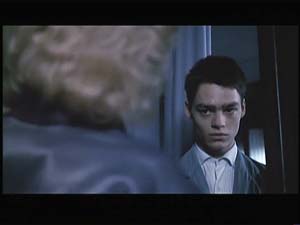
I would like to suggest three basic readings of In a Glass Cage, or broad paradigms with which to begin to interpret the film. They are as follows:
1) In a Glass Cage as Horror of the Mind
The most literal minded reading of the film is to see it within the sub-genre of the “horror of the mind,” films which base their horror on the psychosis of the psychopathic or sociopathic criminal mind (Psycho being the prototype, and including such films as Peeping Tom, Whatever Happened to Baby Jane, The Nanny, Homicidal, Replusion, Sisters, The Tenant, and The American Psycho). Within this reading there is the sub-theme of the attraction to evil, with the film offering two psychopaths, the Nazi Klaus, a pedophilic doctor who takes sexual pleasure in torturing and sadistically murdering boys, and the young, impressionable mind who becomes his protégé, Angelo. The story suggests the “changing of the guard” where the student takes over from the master. In this respect the film is reminiscent of the Stephen King novella “Apt Pupil,” adapted to the screen in 1998 by Byran Singer, in which an adolescent discovers that an old man living in his neighborhood is a Nazi war criminal, and, rather than expose him, blackmails him into recounting his Nazi crimes in all their vivid detail.
2) In a Glass Cage: The ‘Dangers’ of Looking
A second possible reading elaborates on the first by adding a reflexive element centered on the act of watching. In such films the act of murder is in one or several ways aligned with the pleasure of watching, scopophilia (pleasure in the act of voyeurism), and is directly inscribed in the text. As mentioned earlier, the act of looking is deeply inscribed in the film right from the opening pre-credit scene: we see Klaus taking photographs of a boy he has physically abused; he is sexually aroused by sadistically inflicting pain, and in being looked at by the victim. At the same time, Angelo takes pleasure in watching Klaus watch his victims, and later re-enacts Klaus’ Nazi war crimes and forces him to watch them. The sadistic gaze becomes a primal scene replayed and re-enacted over and over. In her analysis Marsha Kinder also makes the connection between Klaus’s immobility in the iron lung and the immobility of the passive spectator at the movie theatre (p. 194-195). Villaronga even goes as far as alluding to this in the dialogue, when the maid looks on uncomfortably at Klaus in the iron lung and says, “The machine makes me nervous, it’s like being at the cinema.” Villaronga underscores this cinematic allusion visually in the scenes where Angelo places a mirror in front of Klaus at such an angle that allows him to see what is happening behind his view. This ‘shadow view’ of reality is a close cousin to Plato’s Cave Allegory, which is often used by film theorists as a (very) loose analogy for cinema (as in Plato’s allegory, the film viewer is ‘strapped’ in their seat; watching an ‘illusion’ of reality projected on a screen, is wrapped up in a fantasy version of reality, etc.).
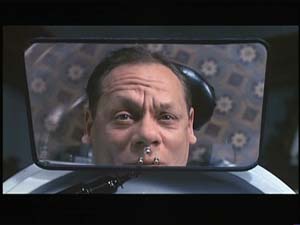
The prototype of the “horror of mind” film Psycho was also instrumental in introducing the sub-theme of the sadistic gaze in its precise structuring of the point of view shot and voyeurism, and the way it shifts audience identity from the hero/victim (Marion Crane) to the killer (Norman Bates/Mrs. Bates). Peeping Tom, made the same year, is a more direct prototype for In a Glass Cage with its central character of Mark Lewis. The Lewis character is a serial killer whose pathology is traced back to the way he was used as a guinea pig by his father in his experiments in fear. In these experiments the father, played by the director Michael Powell, would scare his son for the purpose of recording his reactions on camera. As a young adult Lewis, who appropriately enough works as an assistant camera operator, incorporates the “look of fear” into his modus operandi; which involves murdering his victims with a phallic knife hidden in the bottom of his tripod, and filming the victims as they are forced to watch their own demise through a mirror atop the camera. Other films which inscribe this notion of the painful or murderous gaze within their texts include Mario Bava’s The Mask of Satan (in the wonderful pre-credit scene where Barbara Steele has a spiked mask hammered into her face), Dario Argento’s Opera (in the scenes where the killer forces the heroine’s eyes open by affixing razor blades above and below her eyelids, so that she is forced to watch him murder her boyfriend); John McNaughton’s Henry: Portrait of a Serial Killer (in the scene where the two killers videotape a multiple murder and then watch it on their home television, as if watching a fictional horror film), and in Man Bites Dog (Belvaux, Bonzel, Poelvoorde, 1992) and The Last Horror Movie (Julian Richards, 2004), two films in which the spectator’s position as passive consumer of violence is challenged when the serial killers film their own acts of murders, and in so doing make us complicit with the sadistic act of voyeurism (indirectly in Man Bites Dog through the two filmmakers who begin as passive documentarians of the serial killer’s murders but slowly become active agents, and directly in The Last Horror Movie through the killer’s direct audience address).
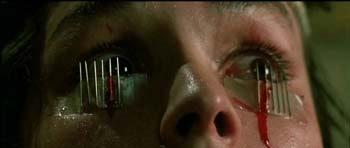
3) In a Glass Cage and National Identity
The third possible source of meaning in the film is figurative rather than literal, and involves placing it within the context of Spain’s social-cultural-political history. The model for such a reading is the book referred to in the introduction, Marsha Kinder’s Blood Cinema: The Reconstruction of National Identity in Spain. In the book Kinder contextualises the violence in In a Glass Cage (along with several other films in chapter 4 of the book) within both the past and the immediate Spanish political and cultural history. For the remainder of this essay I will outline some of the consequences of such a direct social/cultural analysis.
Primitive and Modern Modes of Violence
The main point of Kinder’s analysis in chapter 4 of her book “Sacrifice and Massacre: On the Cultural Specificity of Violence” is to understand a group of films which employ liberal doses of violence [1] within the deeper history of violence in Spain, which includes “the Holy Wars against Moors and Jews, the Inquisition, and the conquest of America, which were pivotal to the creation of the Black Legend….2 (p. 143), and the rich tradition of ‘politicized’ violence in Spanish art which grew out of it (which would include, above all, the works of Goya).
During the Francoist era, the depiction of violence was repressed, as was the depiction of sex, sacrilege, and politics; this repression helps explain why eroticized violence could be used so effectively by the anti-Francoist opposition to speak a political discourse, that is, to expose the legacy of brutality and torture that lay hidden behind the surface beauty of the Fascist and neo-Catholic aesthetics. (Kinder, p. 138).
To elaborate on the ritualistic (eroticized) use of violence in Spanish culture author Kinder refers to two writers, René Girard and his work Violence and the Sacred and Tzvetan Todorov’s Conquest of the Americas. According to Kinder, Girard believes that there is a social/cultural value to ritualized violence: “René Girard argues that the sole purpose of all sacrificial violence (whether in art, myth, ritual, or religion) is the prevention of recurrent reciprocal violence –a theory that makes violence essential to social order and thereby implies it never can or will be eradicated from civilization.” (Kinder, p. 140) As Kinder notes, although the majority of Girard’s examples of sacrificial violence come from the myth and rituals of primitive societies, he also extends his analysis to modern states (Kinder, p. 142). To which Kinder adds, “It is difficult to imagine a modern nation to which Girard’s theory can be more readily applied than Spain, where sacrificial violence has been institutionalized through the national art of bullfighting, the neo Catholic revival, and the Fascist aesthetic, all of which glamorize blood and death.” (p. 142). With respect to Girard’s notion of the value of sacrificial violence as an antidote to ‘reciprocal violence, Kinder refers to the Spanish Civil War: “Spain is also the nation where the fear of rampant reciprocal violence was most recently revived by the fierce atrocities of the Civil War and the bloody reprisals in its aftermath that left over one million dead.” (p. 142-143)
Kinder then introduces the Todorov’s historical theory to further contextualise Spanish violence.
Todorov distinguishes between two rival models of violence: the “primitive” violence of “sacrifice-societies” like the Aztecs…versus the “modern” violence of “massacre-societies” like Spain and other European colonial powers….While Todorov acknowledges that both modes were operative during Spain’s Golden Age sacrificial violence in the Inquisition and modern genocide in the conquest of America), he does not observe that it was this very duality, of simultaneously functioning as a signifier of both primitivism and modernism, that helped make Spain so powerful in that particular historic moment and that was to become so crippling yet definitive in Spain’s subsequent history, keeping the “two Spains” perpetually in conflict. (143-144)
Kinder’s analysis situates In a Glass Cage as a text which incorporates both models of violence, the primitive and the modern. Her discussion begins with the opening scene, which I briefly described above, and underscores its importance by emphasizing how it establishes the themes of ‘eroticized’ violence as a complex model of spectatorship:
bq…in the primal scene…where first the detached yet eroticized kino eye is associated with the killer and then the hand-held subjective camera….The erotic spectacle he [Angelo] is watching is a ritualistic whipping and murder of a young boy suspended on a rope before the voyeuristic Klaus, who photographs the victim before clubbing him to death. Then the subjective point of view switches back to Klaus, as he leaps from the tower, which puts him in the iron lung, where he is infantilized and passive, like his young victims and like the cinematic spectator. Thus, we are immediately positioned, like Angelo, to identify both with the killer and victim, performer and spectator, father and son. (p. 189)
I would like to elaborate on some of the fine points made by Kinder, beginning with the opening scene, which in its first five shots lays out the film’s theme of sadism & cinematic voyeurism and ritualized violence. These first five shots all fade in from dark to light: a close-up of an eye; a close-up of a camera lens; a close-up of dangling feet; a close-up of a Klaus taking a photograph of the hanging boy; and a close-up of small tied-up hands.
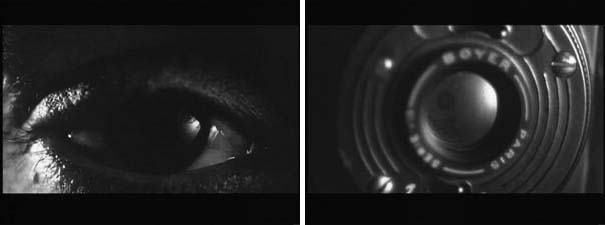
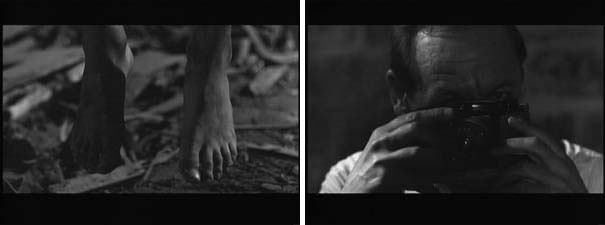
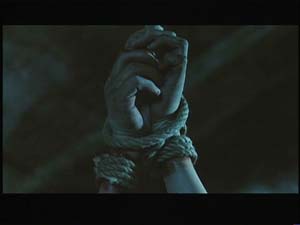
The attention to detail –the eye, the lens, the feet, the hands– not only fetishizes the act for the viewer, but reflects Klaus’ own meticulousness, which is later reiterated by the diary which records his sadistic deeds in precise detail. The hanging position of the boy’s body, bruised and bleeding, also invokes the sacrificial image of Jesus Christ. The use of the 35mm camera as a recording device invokes Todorov’s distinction between primitive and modern forms of violence, with the camera, a modern recording device, photographing a primitive form of death (hanging); while the hanging body itself can be seen as a traditional (primitive) image of religious painting from the Renaissance onward.
Another excellent example of the film’s culturally specific use of modern and primitive modes of violence is the film’s most notorious, and most harrowing scene: the murder of a young boy by gas injection. Angelo has lured a young boy back to the estate as a sacrificial victim in a ritualistic killing where he will restage a murder as described by Klaus in his diary. Angelo places a mirror over Klaus’ face so that his gaze is directly lined up with the shirtless boy strapped to the chair. Angelo takes a syringe out of Klaus’s black medical bag, fills it with gas and then injects it into the boy’s heart (an ironic gesture in that earlier in the film Klaus’ wife Griselda tested Angelo’s qualifications as a nurse by asking him to give the maid a medicinal injection, and was unable to do so). The shot of the needle puncturing the chest is in close-up, and intercut with close-ups of Klaus’s image in the mirror, his face trembling but unable to look away from the horrible sight of the boy slowly gasping to death. The sound of the boy’s gasping is suggestively counter pointed by the sound of the iron lung’s artificial breathing. The mixing of the two sounds is a perverse reminder of the younger Klaus’ sexual arousal at the sound of his victims gasping. The fetishization of the act through close-ups of the syringe, the boy’s chest, mouth, and face and Klaus’s mirror image, and the sound serve to underscore the ‘ritualistic/primitive’ nature of the violence; while the direct reference to World War 2 gas poisoning and genocide and the Nazi concentration camp experiments suggest the modern form of violence.
As in evidence in the above scene, the act of watching as an eroticized act is inscribed at every level in the film, not only with the opening images of the eye and the camera lens, and the shots of Klaus photographing the boy, but with the point of view shots which, as noted by Kinder, shift us from the killer to the silent voyeur. In the context of the 1980s slasher film such a shot –hand-held and withholding character identity– would invoke the presence of the serial killer. In this case we can not assume this, since the serial killer has already been identified with his own point of view shot as Klaus. However, this deliberately ‘faus’ killer’s point of view shot is vindicated later in the film when Angelo assumes the role of serial killer.
In the interview with director Agustín Villaronga included on the Cult Epics DVD (to be discussed later) he says that the film was partly influenced by the story of Giles de Rais (1404-1440), a devoutly religious follower of Joan of Arc who fought valiantly on her side and was later trialed and executed by the Catholic Church for heresy and sexual crimes (sodomy) committed against children, mainly boys, estimates of which range as high as 800. Although there is some doubt as to the validity of Rais’ confession (given under the usual duress of physical torture) and the exact nature of his crimes, most records reveal acts of monstrous sexual sadism, tinged with Catholic ritual.
In an article called “Blood, Fuck, God: The Prodigal Crimes of Gilles de Rais,” Jason DeBoer describes Rais’ murders, which he claims began as early as 1426, as such,
In his in-court confession at his trial, Gilles described how he and his lackeys ‘inflicted various types and manners of torment; sometimes they severed the head from the body with dirks, daggers, and knives, sometimes they struck them violently on the head with a cudgel or other blunt instruments, sometimes they suspended them with cords from a peg or small hook in his room and strangled them; and when they were languishing, he committed the sodomitic vice on them,’ before or even after death.” DeBoer adds that, “Always the aesthete, Gilles looked upon his victims with the eye of a connoisseur, remarking on the boys with the finest skin or the prettiest limbs; he would keep the most handsome of the decapitated heads and kiss them with adoration. Wide-eyed and childlike, Gilles was mesmerized by the act of dying, and this fascination spawned erotic perversions: he often stabbed a child in the neck and watched transfixed as the blood streamed down the tiny neck. This slow dissipation of life enhanced his arousal and Gilles sat masturbating on the bloody belly until he ejaculated.
Much of this imagery makes its way in In the Glass Cage, either directly or indirectly, including a scene where Angelo recreates a scene from Klaus’ diary where he masturbated into the face of a boy. Angelo restages the act by masturbating into Klaus’ face, and then, like a wild animal marking its territory, sadistically arranges for Klaus’ wife Griselda to visit Klaus so that she can see the semen on Klaus’s face.
Given the film’s sadistic sexual dynamics, and the influence of Giles de Rais (and by extension the Marquis de Sade), it is not surprising that the film invokes an Oedipal-driven narrative. After the opening scene we see what looks like a father-son photograph of Klaus, dressed in black, holding hands with a young boy. In a flashback we learn the truth of the image when it is revealed that the photograph came after Klaus had paid the young Angelo to perform fellatio on him. Once Angelo enters the Klaus household his first task is to rid the house of its two women, Klaus’ wife Griselda and the maid Jornalera. The act of eliminating the two women serves both the homoerotic plot and the sadistic-Oedipal plot. This notion of the powerful male is comically treated in the mise-en-scene with the shots of a large, black phallic-like obelisk in the background behind the maid. I owe this observation to Kinder, who refers to the obelisk as “the most direct glorification of phallic rigidity in a film full of transsexual identifications” (p. 194), and who then adds that the obelisk is only one of many fetishized objects: “Indeed, throughout the film, both the camera and the iron lung function as fetishized hardware, machines of desire that amplify the eyes for voyeuristic pleasure and the lungs for the heavy breathing of sex and death that also arouses pleasure in the sadistic killer.” (p. 194) Once the two women are out of the way, Klaus begins to wear a black coat identical to the one Klaus was wearing in the photograph and begins to assume the power of the father. He even says to Rena, “I am your father now.” With this, the film shifts the sexual dynamic from the homoerotic, which informs the first half of the film, to the Oedipal.
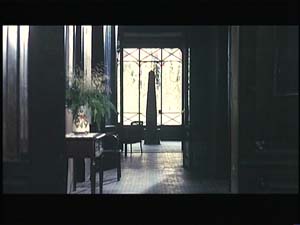
In conventional psychoanalytic terms masochism –pleasure from one’s own pain, humiliation or submission– is pre-Oedipal and takes place during the time when the mother is all powerful and the source of the child’s identification: from womb, to breast. Sadism is post-Oedipal, meaning that it takes shape when identification shifts from the mother to the father. Freud understood this dynamic as “sadomasochism” where both elements where part of the sexual whole, with sadism as the dominant sexual instinct and masochism as a transformative part. Kinder quotes Gilles Deleuze from his book Masochism: An Interpretation of Coldness and Cruelty to elaborate on the potential of sadism-masochism to be two separate sexual perversions and distinct aesthetic discourses in opposition to Freud’s “single entity model of sadomasochism” (Kinder, p. 148): “Deleuze claims that their [Marquis de Sade and Sacher von Masoch] respective aesthetic discourses rearrange the power dynamics of the Oedipal family in two opposing ways.
The masochist’s experience is grounded in an alliance between the son and the oral mother; the sadist’s in the alliance of father and daughter…. Sadism stands for the active negation of the mother and the inflation of the father (who is placed above the law). (Kinder, p. 149)
Angelo’s elimination of the two women –Griselda and Jornalera– reflects the “negation of the mother” while his stealing of Klaus’ diary, wearing of the black coat, and his acts of sadism and ritualized serial killing reflect “the inflation of the father.” The only missing piece is the “alliance of the father and daughter” which occurs in the film’s final scene, which completes the sadistic Oedipal transformation. Out of a surrealistic blue shadow in dark silhouette emerges the body of what looks like a young boy. When the face becomes visible we see that it is Klaus’ daughter Rena, transformed into a boy through her short hair and schoolboy outfit, her face ‘painted’ in blood recalling the victim in the opening scene. Rena mounts the iron lung, as did Angelo earlier in the film, only now Angelo is inside the iron lung. The transformation is complete, with Angelo becoming the ‘father’ by assuming Klaus’ position in the iron lung, and Rena, dressed and groomed like a young boy, assuming the role of the “son” Angelo.
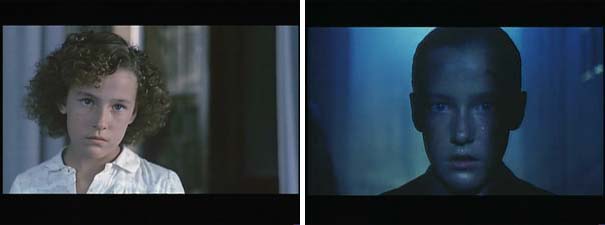
The Meaning of Red
On the DVD interview Villaronga notes the importance of color in the film and how he and his cinematographer (Jaime Peracaula) wanted to eliminate color as much as possible by choosing a spectrum of cool, steely tones, influenced by the Belgian painter Andre Vox. Within this cool spectrum Villaronga chose to highlight the color red on three occasions, which he lists in the interview: Griselda’s red bathrobe when she goes to the basement to turn off the electricity; the red curtains that Angelo strips off the wall to wrap Griselda’s corpse with; and the red blood that flows down from a slashed boy’s throat to his chest.
Of these instances the latter two are the ones with greatest significance with respect to the notion of ritualized violence. The red curtain directly relates to the red cape used by the matador in bullfighting, while the shot of the blood flowing down onto the chest framed from below the neck evokes both the ‘blood of the beast’ and the act of animal sacrifice. In Spanish culture the color red easily invokes its National past-time of bullfighting. Quoting writer Federico García Lorca, Kinder observes that “Spain is the only country in the world where death is a national spectacle.” (p. 142) Villaronga reiterates the importance of cultural meaning to the film’s violence when he says, in the DVD interview, “We tried to turn the house into its own character….It was important for me, to make everything going on in this house, look as if it were a bullfight…and all the forces driving to the center of where it would all happen, the deaths.” By placing these ritualistic “primitive” forms of violence (bullfighting, animal sacrifices) within the context of a “modern” form of violence (the genocide and ‘massacre’ nature of Nazism), Villaronga evokes the dual edged aspect of a “two Spains” where both forms of violence still co-exist in their art and culture.
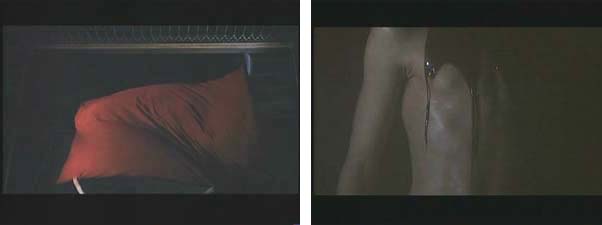
Although I have spent a good deal of time outlining the potential rewards of a cultural analysis of In a Glass Cage, even a strictly formal/stylistic reading of In a Glass Cage can reveal a richly textured horror film dense in suggestive imagery. It is a highly controlled piece of filmmaking in which the mise en scene slowly evolves to echo Klaus’ insular and hermetically sealed existence. The iron lung is the most obvious physical manifestation of the film’s emotional claustrophobia, but this dynamic is reflected in many other aspects of the film: the constantly closing doors, the progressively darkening lighting scheme in the house, the elaborate set-piece of Angelo stalking and killing Griselda in the upper floor of the estate, while Rena paces in her room like a trapped beast, Angelo’s predatory excursions into the city to seek out new victims, the mesh cage Angelo constructs in the hallway, the many images of characters framed in tight corners or spaces, to the final allegorical image which freezes Angelo and Rena in a glass ball (a possible homage to Citizen Kane).

To conclude, I should state that this film has been one of the holy grails of horror aficionados during the pre-DVD era. It was one of those talked about but difficult to see films whose reputation had been built on the basis of poor quality bootleg videos or legitimate but murky video transfers. With this in mind, the “Special Edition” DVD release from Cult Epics is something to rejoice about. Thankfully, the film is in its proper 1.85 (non-anamorphic) aspect ratio, with original Spanish dialogue and clearly legible optional English subtitles. The rather spartan “Special Edition” comes with a text reprint of Stephen Thrower’s excellent analysis of the film (from The Eyeball Compendium) and a very informative, if brief (10 minutes), interview with the director Agustin Villaronga, in which he discusses the origins of the story, the stylistic use of color and location, and the acting. Cult Epics has done an admirable job of transferring the film’s demanding color palette of neutral colors and high contrast cinematography (as evidenced in the still frames taken from the DVD), leaving us with a transfer far better than anything that was available before and that should stand as the definitive version for a long while.
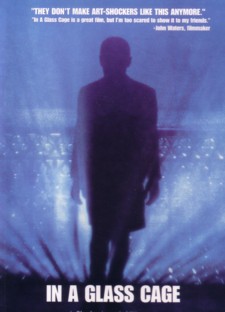
Endnotes
1 Other films Kinder discusses include La caza (1965), Peppermint frappé (1967), Pascual Duarte (1975), Camada negra (1977), Los ojos vendados (1978), and El crimen de Cuenca (1979))
2 “The anti-Spanish Black Legend…is the depiction of Spain and Spaniards as bloodthirsty and cruel, greedy and fanatical.” Wikipedia: The Free Encyclopaedia. Accessed Dec. 30, 2005.
Bibliography
Clover, Carol. Men, Women, and Chainsaws. Princeton, New Jersey: Princeton University Press, 1992.
DeBoer, Jason. “Blood, Fuck, God: The Prodigal Crimes of Gilles de Rais.” Fierce Language. 2001 Accessed December 28, 2005.
Hawkins, Joan. Cutting Edge: Art-Horror and the Horrific Avant-Garde. Minneapolis-London: University of Minnesota Press, 2000.
Kinder, Marsha. Blood Cinema: The Reconstruction of National Identity in Spain. Berkeley and Los Angeles: University of California Press, 1993.
Sconce, Jeffrey. “Trashing the Academy: Taste, Excess, and an Emerging Politics of Cinematic Style,” Screen 36, no. 4 (Winter 1995).
Williams, Linda. “Film Bodies: Gender, Genre, and Excess,” in _Film Reader II, ed. Barry Keith Grant. Austin: University of Texas Press, 1995.



